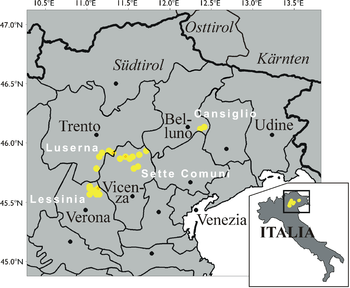Sette Comuni

The Sette Comuni, Cimbrian: Siben Komoin, German: Sieben Gemeinden, are seven comuni that formed a Cimbrian enclave in the Veneto region of north-east Italy. Cimbrian, a dialect of Upper German, was the native tongue, and the area was ethnically and culturally diverse from the surrounding comuni.[1]
History

The comuni are on the Altopiano di Asiago, a high plateau northwest of Vicenza. They are:
| Comune | Cimbrian | German | Inhabitants | Altitude (m) | Notes |
| Asiago | Sléghe/Schlège | Schlägen | 6533 | 1001 | |
| Enego | Ghenébe/Jenève | Jeneve | 1927 | 800 | |
| Foza | Vüsche/Vütsche | Fütze | 731 | 1083 | |
| Gallio | Gell(e)/Ghèl | Gelle | 2331 | 1093 | |
| Lusiana | Lusaan | Lusian | 2833 | 752 | |
| Roana | Robàan | Rovan or Rain | 4245 | 994 | |
| Rotzo | Rotz | Ross | 620 | 938 | |
| Conco | Kunken | 2252 | 830 | the "eighth comune", a frazione of Lusiana until 1796 |
The seven comuni formed together into a loose commonwealth in 1310. They were historically under the suzerainty of the Milanese House of Visconti and then under the Republic of Venice. Under both they enjoyed wide cultural and political autonomy in exchange for their loyalty. The autonomous status came to an end with the Napoleonic Wars and the demise of the Serenìsima in 1807.
Due to the high pressure from the Italianisation from fascists such as Ettore Tolomei and the government of Benito Mussolini the Cimbrian language eventually almost completely disappeared. Only in Robàan and its district Mittebald/Toballe (Mittewald, Mezzaselva) has Cimbrian survived.
Robàan has the cultural institute "Agustin Prunner" which is a repository of the Cimbrian culture and cooperates with other linguistic enclaves in Lusern, Fersental, Sappada, Sauris, the Thirteen Communities and Timau. Vestiges of the once dominant language are family and place names, which are mostly still Cimbrian.
See also
References
- ↑ l'Altopiano di Asiago e la Spettabile Reggenza dei Sette Comuni (in Italian). magicoveneto.it. Accessed September 2013.
External links
- Asiago 7 Comuni news and information
- Asiago.to (Italian)
- reggenza7comuni.it (Italian)
- Tourism website (Italian)